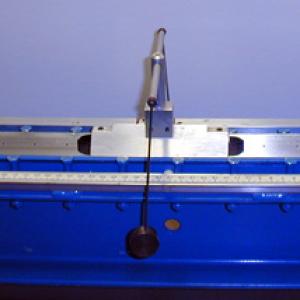College of Liberal Arts & Sciences
1D40.50 - Air Track Pendulum
Start the pendulum swinging and then push the whole cart and pendulum system down the air track. The car will seem to start and stop as it moves down the track. However, if you look at it with videotape or video capture you will see that the center of mass of the whole system moves at a constant velocity.
The large center of mass pendulum is in the basement. Start the mass swinging and depending on when you release the system, the system will oscillate in place or will travel across the room in what seems to be jerky movements. If you video this movement you will see that the center of mass of the system travels smoothly at a constant velocity.
- Tarek A. Elsayed, "Interpreting Recoil for Undergraduate Students", TPT, Vol. 50, #4, Apr. 2012, p. 209.
- Margaret Stautberg Greenwood, "Conservation of Momentum and the Center of Mass of a Cart - Truck System", TPT, Vol. 25, # 6, p. 370, September 1987.
- Akio Saitoh, "Conservation of Momentum - Walking the Boat", TPT, Vol. 23, # 5, p. 316, May 1985.
- W. Klein and G. Nimtz, "Inelastic Collision and the Motion of the Center of Mass", AJP, Vol. 57, #2, Feb. 1989, p. 182.
- Mp-1: Freier and Anderson, A Demonstration Handbook for Physics.
- M-486: "Swivel Hips - Pendulum on Cart", DICK and RAE Physics Demo Notebook.
- M-125: Richard Manliffe Sutton, Demonstration Experiments in Physics.
Disclaimer: These demonstrations are provided only for illustrative use by persons affiliated with The University of Iowa and only under the direction of a trained instructor or physicist. The University of Iowa is not responsible for demonstrations performed by those using their own equipment or who choose to use this reference material for their own purpose. The demonstrations included here are within the public domain and can be found in materials contained in libraries, bookstores, and through electronic sources. Performing all or any portion of any of these demonstrations, with or without revisions not depicted here entails inherent risks. These risks include, without limitation, bodily injury (and possibly death), including risks to health that may be temporary or permanent and that may exacerbate a pre-existing medical condition; and property loss or damage. Anyone performing any part of these demonstrations, even with revisions, knowingly and voluntarily assumes all risks associated with them.
